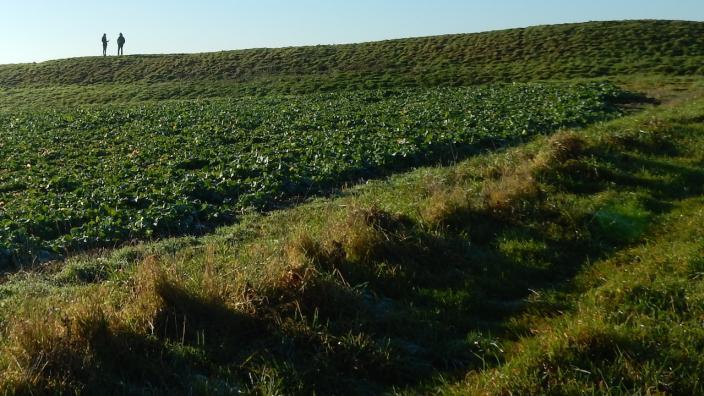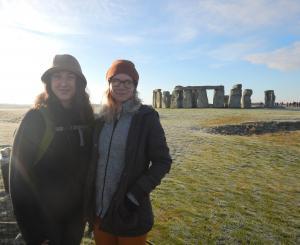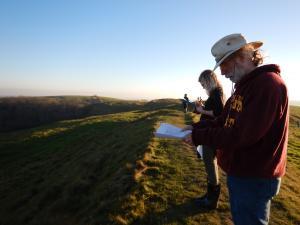Driving on the narrowest of roads in the early morning hours, Paige Melius and Cassandra Ortberg are getting their first taste of typical English weather. It’s foggy and wet. The driving lanes are so narrow that Paige needs to pull onto the verge (roadside grass) to let other cars pass. Cassandra uses a topographical map to provide directions to their destination. They scan the fields for elongated mounds of chalk.
Finally, they find what they’ve been looking for. An ancient burial mound called a long barrow, rises up out of the countryside. They pull on their rain gear and hike to the barrow. Reaching the top of the mound of chalk covered by grassy turf, Paige takes out her Brunton compass and takes an accurate reading of the barrow’s axis. Cassie does the same but from the other end of the mound. They observe the size and condition of the barrow and the physical features of the adjoining landscape, and record the information on field data sheets specially prepared for their work. They are looking for an answer. Why was this particular long barrow built; is there a reason for its orientation; and why was it constructed at this exact spot?Paige and Cassandra are a long way from home this winter break. Paige, who comes from Woodbridge, Virginia and Cassandra, who's hometown is Zimmerman, MN, say the opportunity to study the long barrows gives them unparalleled experience in their field, earth and environmental science. Under the guidance of Paul Burley, a Ph.D. candidate in archaeological geology at the University of Minnesota Twin Cities, these two undergraduate seniors are conducting research near Stonehenge in Wiltshire, England.
Paige, Cassandra, and Paul are spending ten days researching and measuring many dozens of long barrows and additional features such as cursus monuments built more than 5000 years ago that extend as much as 10 km across the English countryside.
Cassandra and Paige were approached about the research opportunity by Professor Howard Mooers, head of the Department of Earth and Environmental Sciences at UMD. Cassandra and Paige were quick to jump at this opportunity to study abroad.
“I love to travel,” Cassandra says. “I love to see new places, to experience new things.”.
BARROWS AND CURSUS MONUMENTS
This is certainly something new. Paul's research of the Stone Age long barrows and cursus monuments near Stonehenge focuses on the monuments’ architectural symbolism, construction, and placement as they relate to the landscape and the stars and constellations as they were perceived when the chalk mounds were built.
A cursus is a central feature of the Stonehenge site, measuring 2.7 km long and spanning the width of a football field. The barrows, located within ancient burial grounds and ritual sites, date back to 3600 BCE, during the Neolithic era. There are five Bronze Age round barrows at one end of the cursus and a long barrow at the other.
For this project, it is the orientation of the cursus and the long barrows that are of particular concern. “We’re interested in axial orientation of the long barrows, because the round barrows lack such orientation,” Paige says. These features may be related to astronomical alignments and geometrical relationships between the barrows and cursus.
All three team members have an interest in environmental, geological and engineering studies, and relationships between societies, the environment and the structures they build.
Paul’s research spans all of Great Britain, including Scotland where he has researched symbols engraved on stones found in the oldest village in Europe. He points out we might never know for certain what the significance or purpose of the long barrows were meant to be.
Paige and Cassandra are excited about their prospects. Paige wants to travel and possibly work abroad. Cassandra wants to stay closer to home and hopes to find a job in the local community after graduation. They both agree, their experience with Neolithic ritual sites is just the beginning.


